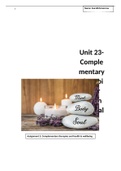1 Name: Zae12Mcmorrow
Unit 23-
Comple
mentary
Therapi
es for
Health
& Social
Care
Assignment 2- Complementary therapies and health & wellbeing
, 2
P5- Explain the advantages and disadvantages of complementary therapies in maintaining
health and wellbeing/ M3- Discuss the role of two complementary therapies in
maintaining health and wellbeing/ D2- Evaluate the effectiveness of two complementary
therapies in maintaining health and wellbeing.
In this task, I’ll be explaining the advantages and disadvantages of complementary therapies
in maintaining health and wellbeing. Also, I’ll be discussing the role of two complementary
therapies in maintaining health and wellbeing. Finally, I’ll be evaluating the effectiveness of
two complementary therapies in maintaining health and wellbeing for Sandra.
Sandra, a 38-year-old woman, is a mother of
two. She works full-time as a social worker and
will occasionally work extra on weekends and
evenings if her job necessitates it. She
appreciates her profession and the emotional
rewards she derives from assisting others; but
she is constantly under pressure, which causes
her to be depressed and anxious. Because she is
continuously anxious, she believes this is one of
the main reasons she gets migraines. She is happily married and has two children. They
share a two-bedroom flat in Central London. Sandra suffers from endometriosis, a disorder
that causes her severe menstrual pains and other symptoms. This interferes with her career
and social life, and she can become bedridden in severe flare-ups.
Sandra is a reasonably healthy lady who goes to a martial arts class every two weeks and
has always pushed her family to eat healthily. She recently received a diabetes diagnosis
and is concerned about how it will affect her lifestyle. She believes that most of her health
problems are caused or exacerbated by stress, and she is looking for ways to cope better
with the high intensity of her life. Sandra has a variety of health issues, so it's only natural
that she's on a variety of medications to help her manage the symptoms of all of them,
including insulin and metformin for diabetes. As a result, she has done a lot of research into
experimenting with complementary therapies. For example, Acupuncture was used to treat
her Endometriosis, Massage therapy was used to treat her Diabetes, Reflexology was used
to treat her despair and anxiety, and Aromatherapy was used to reduce her stress levels.
Acupuncture is known to stimulate the body's nerve system and send messages to the
nervous system to assist the process of self-healing, which is one benefit of utilising it to
treat endometriosis (acupuncture, 2021). The body's homeostatic systems are influenced as
a result of the biochemical alterations, which promote physical and mental well-being.
Acupuncture points that are focused on a person can assist to alleviate pain and tension,
which can be very beneficial when treating endometriosis, which can be a highly severe
condition. One risk of adopting acupuncture rather than conventional therapy is that if it
does not work, her endometriosis may worsen, posing a serious threat to her life.
Furthermore, in some cases, endometriosis is treated surgically, so acupuncture would be
ineffective in those cases. As a result, Sandra might benefit more from seeing a doctor first
(acupuncture, 2021).





